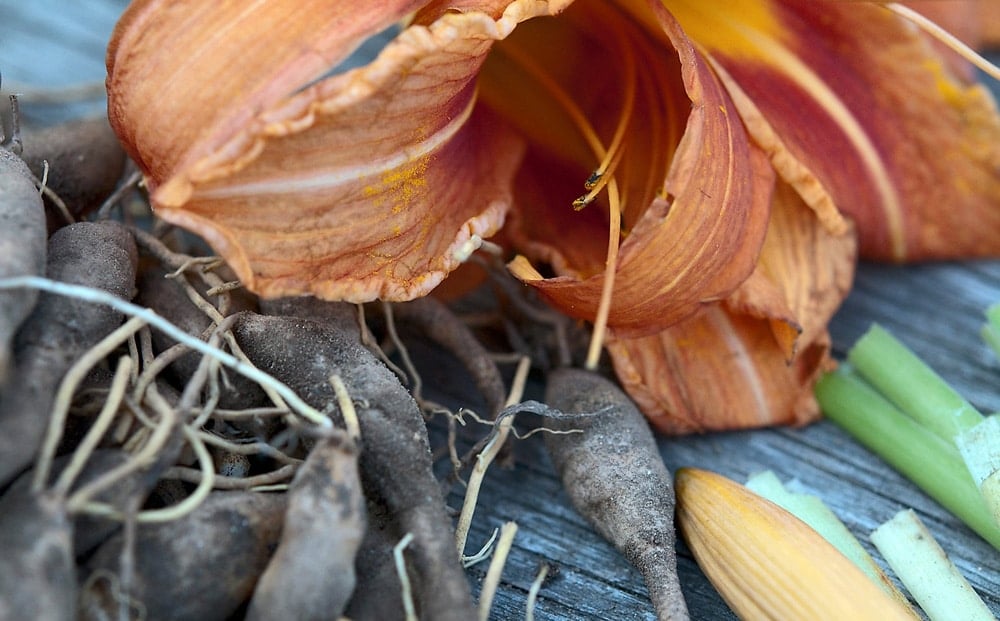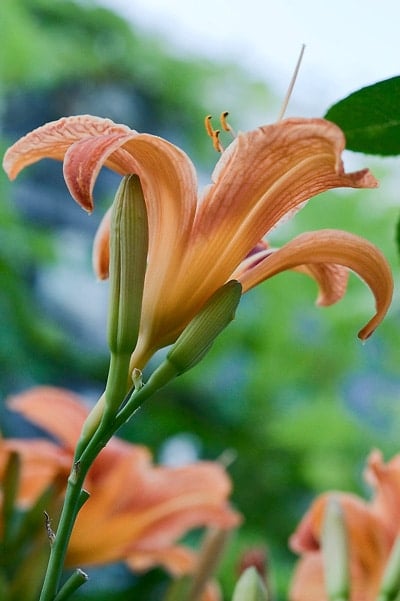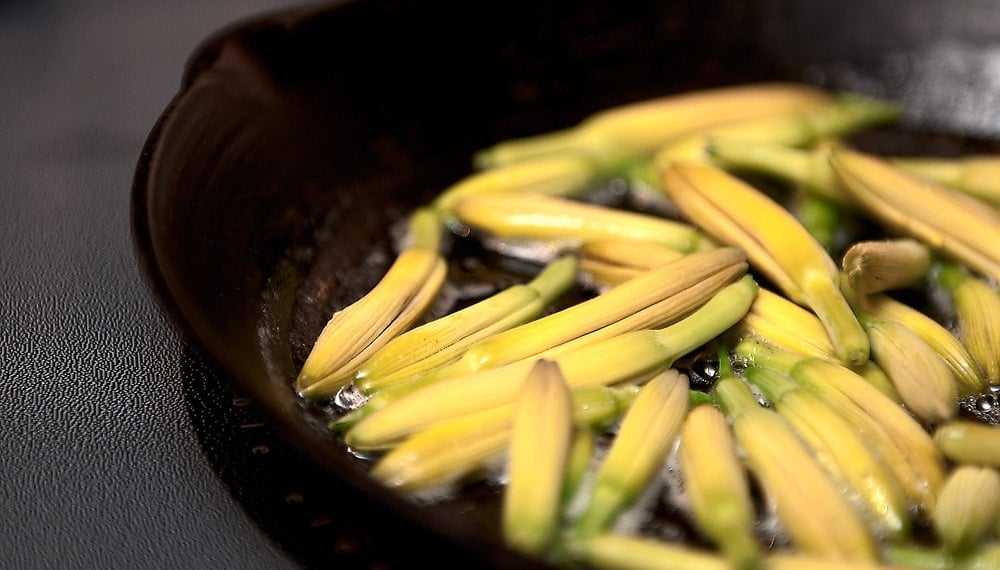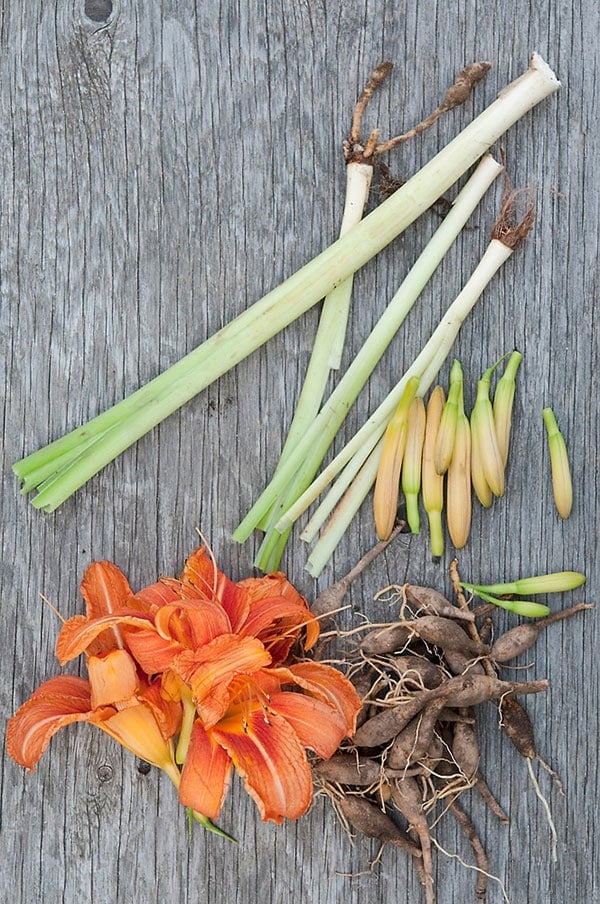As an Amazon Associate I earn from qualifying purchases.

Daylilies are not only edible, they are spectacular. After sampling the flowers, flower buds, young stalks and root tubers, I’ve come to the conclusion that they’re so tasty I may grow them as a food crop.
Let me start by saying that edible daylilies are the common daylily, Hemerocallis fulva, as well as its various Hemerocallis friends and relatives; there are thousands. What I am most definitely not talking about are bona fide lilies, like the Easter lily, which, if you are unfortunate enough to eat, you had better hope that the Resurrection is real…
I’d read long ago about the edibility of the common lily of my youth, which we incorrectly called tiger lilies because of their orange stripes. But this would have been in the 1980s, when edible flowers reached their trendy zenith. Nasturtium flowers all over the plate, anyone? Meh. My young self wrote off lilies as part of that prancy fad.
I first foraged for daylilies in Massachusetts, years ago. Any of you ever been to Cape Ann? Gloucester is covered in daylilies, and its ritzier neighbor Rockport has more daylilies than grass. Daylilies are the most common flower on the whole freaking island. So common my sister Lizz and my brother-in-law Mark have tons of them in their tiny yard.
So I am sorry to tell you there will be no stirring tale of high adventure as we stalked the semi-wild daylily. Nope. We just pulled a few plants and picked the flowers and buds from some others that were in the yard.

The drama with daylilies is all in the eating.
I first separated the plants into flowers, buds, and tubers — unlike true lilies, daylilies don’t have bulbs, they have little tubers instead that look like miniature fingerling potatoes. I then stripped the outer leaves from those plants that had not yet flowered, until I got to the white part.
Most sources say to saute the unopened flower buds with a little butter or oil and call it a day. Sounded like a plan, especially since I wanted to really taste the plant, not any supplemental seasonings. So in they went, just lily buds, butter and salt.

Delicious. Briefly cooked, the buds have a bit of knacken, a German expression meaning a “pop.” Yet the insides reminded me of squash blossoms. The taste? Green, with a whiff of radish and a dash of green bean. Honestly, I’d eat this as a side dish any day, any place. It needs nothing else.
We tried some of the stalks, but they were not as good. Texture like lemon grass, only without the wonderful lemon aroma. More like a bland, tough scallion. Certainly edible, and not terrible, but nothing like the buds.
The flowers are OK. They are more for color than flavor, and they are said to thicken soups the way okra or file powder do. The Chinese use them in hot-and-sour soup. Will have to try that more some other time.
That left the little tubers. First thing I noticed was that some looked exactly like fingerling potatoes, while others were pure white, like the inside of jicama. I ate a white one, and it tasted like jicama — only better. Like a raw sweet potato. Or rather a sweet, raw potato, not a yam.
I did the same treatment to the tubers: Butter, salt, saute. Only I added some black pepper this time. I like black pepper on my potatoes, so I reckoned I’d like this, too.
I was right. These are quite possibly the best tubers I’ve ever eaten. OK, that might not sound like ringing praise, but consider that I am including real potatoes in there and you get the picture.
Think really young fingerling potatoes, only with a sweetness to them. White ones are sweeter than the yellow ones. Yellow ones seem more substantial.
The only things daylilies have against them are allergies and size. A small number of people who eat daylily flowers get farty and nauseous afterwards; I hear “less than 5 percent” a lot, but I can’t verify it. Suffice to say you should eat only a little at first, the have at it.
The second “strike” against the lily, if it can be called one, is size: You’d need to uproot about five or six plants for one meal. But when you consider that hemerocallis fulva is considered a noxious weed in many of the 42 states it’s gone feral in, go ahead. Dig away.
Doing a little more research, I find that according to the USDA, the daylily has gone wild in every state except Alaska, Hawaii, Oklahoma, North Dakota, New Mexico, Arizona, Nevada, and, um, my own state of California. Sigh.
That said, you can’t swing a dead cat without seeing a planting of edible daylilies in a parking lot or person’s house, and they are so common in urban settings Charlotte Bringle Clarke writes about them in her Edible and Useful Plants of California.

Daylilies originally came from Asia, probably China. Chinese cooking uses them all the time, even in such starring dishes as moo shu pork and hot-and-sour soup. You will often see dried flowers called “golden needles.”
Euell Gibbons liked to batter-fry the buds, and lots of other old-timers “creamed” their daylily tubers, which sounds unappetizing. But beyond hippie forager types and the Chinese, I’ve found no other use of the daylily as food.
Pity. It is, as Jimmie Walker would say, Dy-No-Mite.





Although I had a million of these things in my yard, never thought of eating them. Thanks for the article
Glad you had fun experimenting with daylilies. I like the flowers in soups and salads, and they’re especially attractive stuffed. As a vegan, I make a mock cottage cheese which I sweeten, season with herbs, and mix with apricots and nuts.
You weren’t able to test the shoots, which are in season in late winter and early spring. They’re great raw, sautéed, stir-fried, in soups, casseroles, grains, or any savory dish, and they’re easy to collect in quantity.
Anyone who wants to learn more about foraging is invited to visit my site, https://www.wildmanstevebrill.com, or download my iPhone/iPad/Android app, Wild Edibles.
Happy Foraging!
on the same subject (that is, foraging wild food), you can also eat cattail tubers…if you are lucky enough to live near a pond with them growing. Just pull the whole plant out in the spring when they’re more tender…slice and boil and fry…or dry the tubers and grind into a flour/paste.
hmmm…just ate a bunch of tubers feel a little bloaty in my tummy, maybe i should have headed the warnings…i wonder if the pickles i made would cause same reaction
I will! Thanks Hank!!
Annette: You could blanch the buds and vacuum seal them. As for the tubers, I would not freeze them. Just eat them in their season!
I was wondering if you could freeze the buds and tubers??
I pull the blooms off at the end of each day and eat them raw. They usually have a little bit of nectar in the bottom still.
Smaller than SunChokes but when I got some for free I saw the tubers and was like I bet they are edible. Not feeling like I needed to look it up cause I was not tempted to eat it, I just planted them. Well let me tell you I will add them to my just in case garden that is little known food plants away from my main garden. just in case things get bad and the obvious gets raided. 😉
I have tried the blossoms with lettuce and onions cut up. put in a large pan fry a lb. of bacon, put a half glass of water. with a t-spoon of vinegar in the pan with a little of the drippings while on the heat carefully. Don’t get steam burned. pour over the lettuce, blossoms, and onions slowly stirring them to wilt them. Goooooood but don’t eat to many. They can cause dihrea. I eat two small helpings, and it don’t bother me.
Blessings,
Charlie H. Barrett
I picked and sauteed some of the common orange daylily buds we have abundantly growing in our yard this evening. Yum! They remind the hubs and me of the taste of asparagus. We didn’t eat a whole lot. Hopefully we’ll be alright to eat more. They sure are a lot easier to grow than asparagus. If our tummies stay happy, I’ll harvest some tubers.
My house is surrounded by day lilies and I can’t wait to try dome of these suggestions. I’m getting into foraging for wild edible food, and expanding my horizons of what’s “food” to beyond what’s marketed to me.
Heed the warning about trying a small amount first. I am part of the unlucky 5% who, although LOVED the taste, got very sick. Great way to prepare for a colonoscopy!
Now I understand why the deer won’t leave them alone!
Great post. Interesting to hear such rave reviews – I planted daylilies in my garden earlier in the year specifically because I knew they were edible & my garden is 100% edible (so they’re good for a bit of colour). There’s actually a daylily recipe book: https://tinyurl.com/27bg8k6
It makes interesting reading if you can find a copy.
Cindy: I bet you can find daylilies in the Netherlands. As for the hunting/fishing, to each his own — but you’re not alone. There are a lot of vegetarians who read this space just for the foraging and veggie recipes I do. Not everyone is going to be into every post I do, but over time you’ll see as much about veggies as about deer or fish.
Thank you for mentioning: Golden Needles. Now I know what you are talking about. Unfortunately in its dried form!. Now I wonder where/if I can find daylilies in The Netherlands.
In ejoyed your blog very much. BUT I have problems with how you killed/hunt animals and sharks! I am a vegetrarian in heart. I have to skip those entries very quickly 🙁
Tori: Wow, I am SO sorry! I have never heard of someone having that strong a reaction! The people I know who can’t eat them say they get a stomach ache and a little nauseous. How many did you eat? If you only ate a few, it might be pesticides. If you ate a whole plateful, it might be a “normal” reaction, only you ate more than most people do when they try new wild foods.
In general, it’s always good to try a little of a new food first to see how you react to it. This is especially true with mushrooms, by the way — many edible mushrooms don’t agree with some people.
Hope you’re OK!
I tried some buds of the multitudes of daylilies near my home. Delicious, however, I threw up the whole lot about 30 minutes later! I know they sometimes give upset tummies, but I wasn’t expecting such a violent reaction. Could they have had pesticides sprayed on them?
Thank you, Thank you, Thank you! Was up at the in-laws cabin in Potter County, PA (aka God’s Country), and we have day lillies everywhere. I had my 8 and 9-year-olds forage a big bag of buds on the night when it was just our family. We did them up with butter,salt, and pepper on a cast iron skillet above the fire pit. Fantastic! We all loved them and my two youngest kids were so proud of their foraging efforts. When the in-laws arrived, I offered a repeat performance but they declined due the slight chance of flatulence–not even after I pointed out most of the rest of the things we were eating had a higher chance. Oh well–their loss. We will definitely be making these again. And again–thanks!